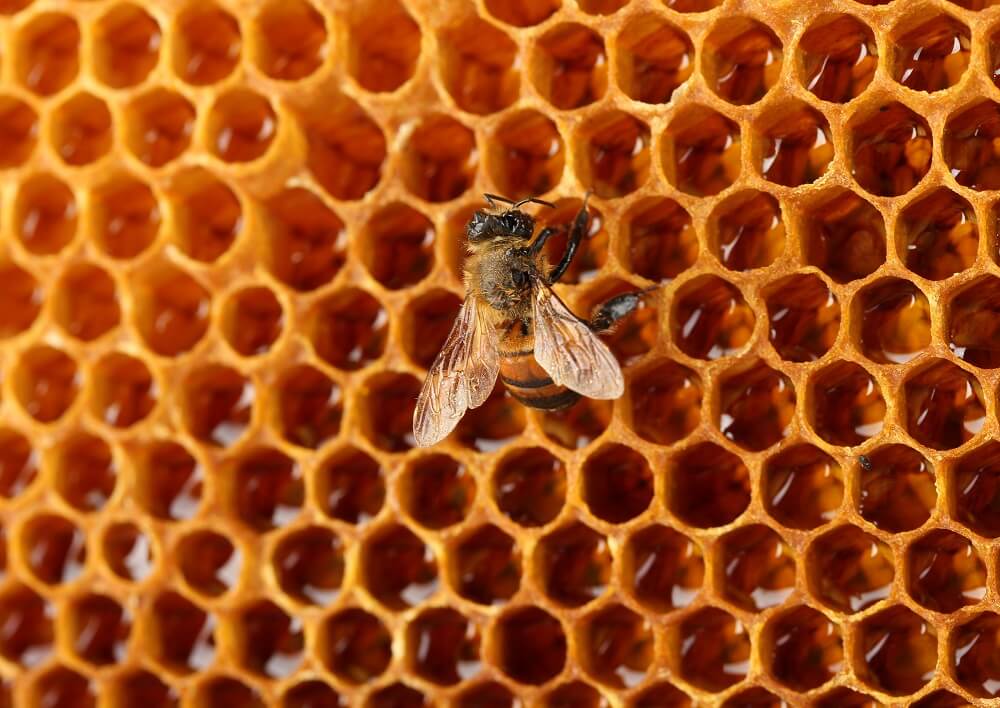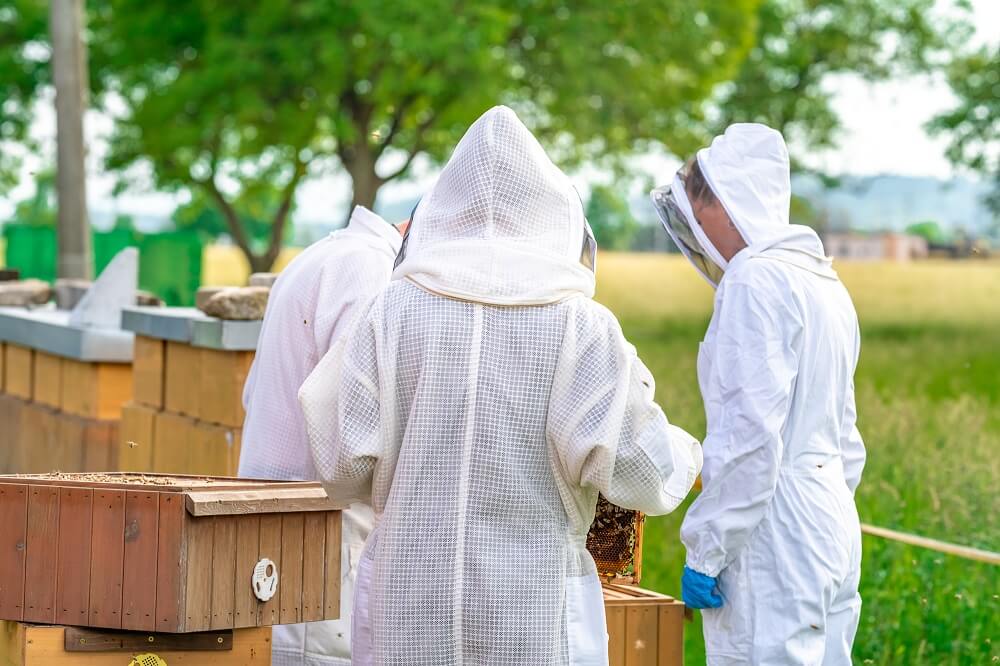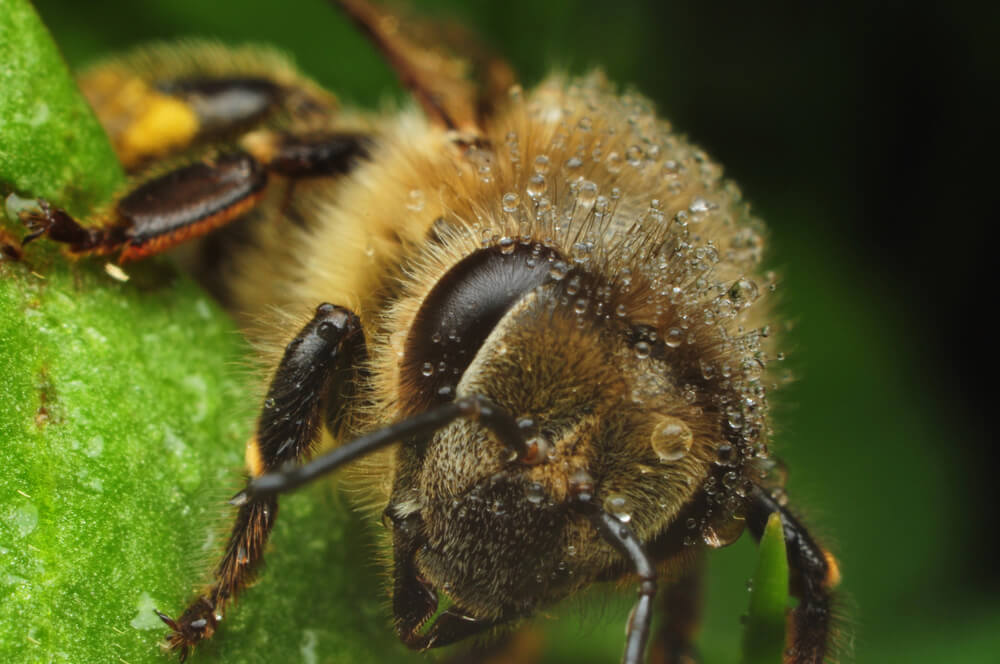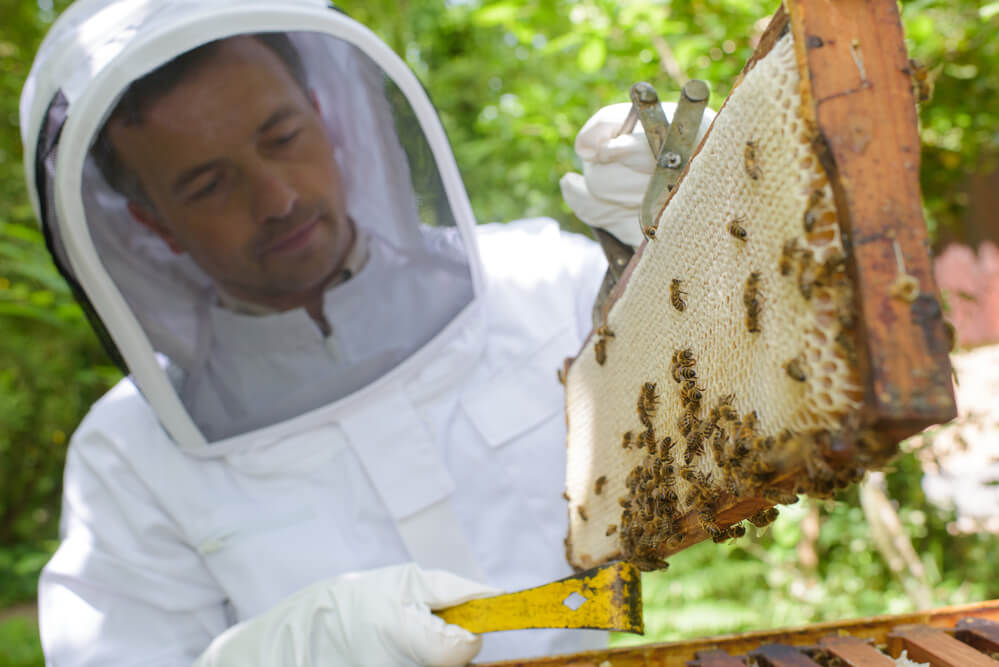Table of Contents:
Which Direction Should a Beehive Face for Best Pollination?
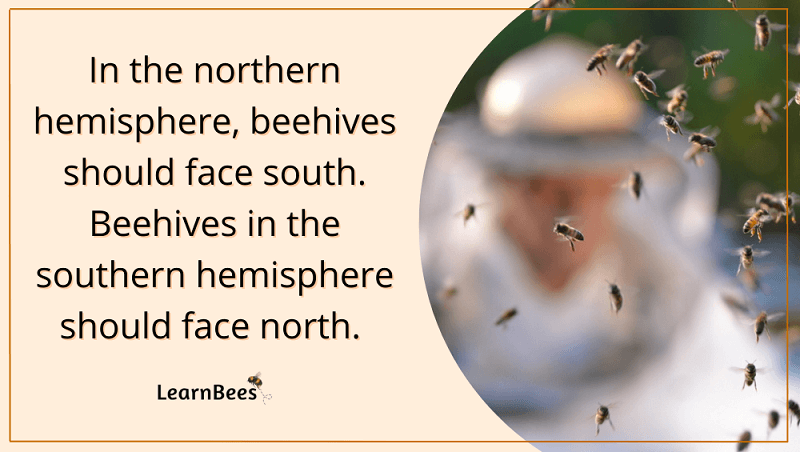
In the northern hemisphere, beehives should face south. The northern hemisphere includes:
- North America
- Central America
- Asia
- Europe
- Northern Africa
- Part of South America
Beehives that face south provide the honey bees with a warm, solar-heated porch from which they can take off and land.
During the winter, the sun doesn’t rise exactly in the east. Instead, the winter sun rises slightly south of the east and sets south of the west. As a result, a south-facing beehive is especially important during the cold months.(1)
Why?
Because bees need that extra warmth to venture outside on sunny days for their “cleansing flights.”
A cleansing flight occurs when honey bees take a quick bathroom break outside the hive. They’ve been clustered inside the hive for days, weeks, and even months during the winter. Cleansing flights are necessary for the colony’s survival. If bee feces builds up inside a hive, it can lead to nasty diseases that put the colony at risk.
Additionally:
A Canadian bee researcher, Tibor Szabo, studied the differences between south-facing and north-facing hives.
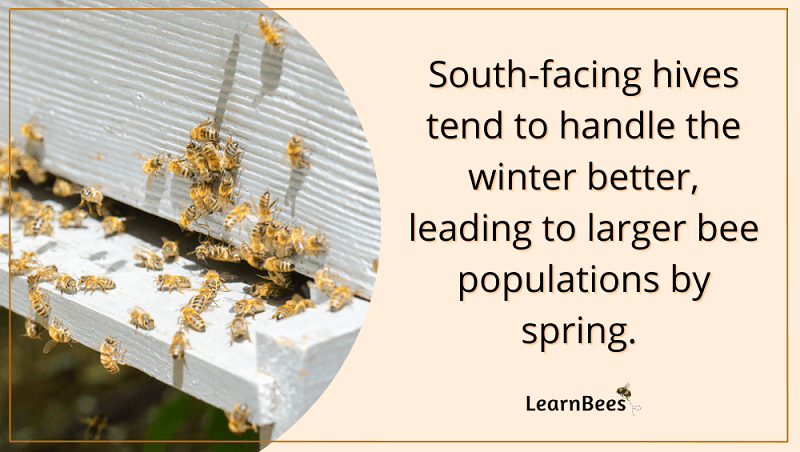
He found that those in south-facing hives were less likely to have their hive entrance plugged by ice in the winter. These colonies also had larger populations by spring.(1)
With that in mind:
The opposite is true for beekeepers living in the southern hemisphere. Beehives in the southern hemisphere should face north. The southern hemisphere includes:
- Australia
- South America (the middle and lower half)
Now, I know what you might be thinking:
Does it truly matter which direction my beehives face?
The truth is?
Honey bees are tough little creatures.
They’re adaptable to a myriad of different conditions. This explains why honey bees are found on every continent except Antarctica. So if you can’t face your beehive in the right direction for whatever reason, it’s not the end of the world.
However, we always recommend mimicking a honey bee’s natural environment. Wild honey bees prefer south-facing nests (northern hemisphere) and north-facing nests (southern hemisphere).
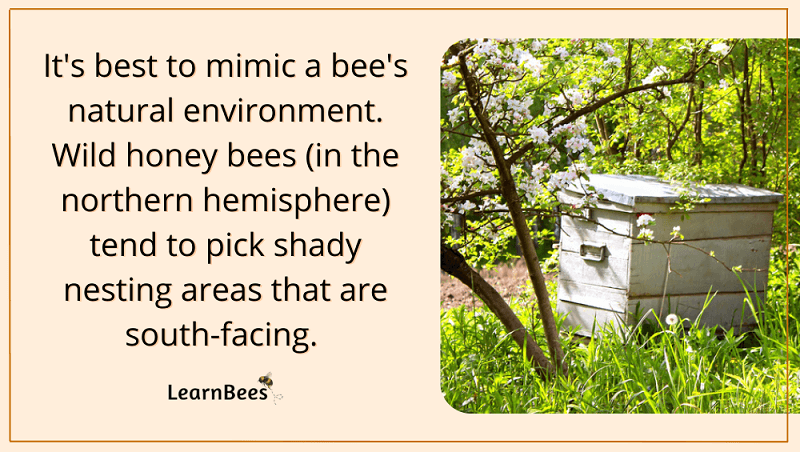
How do we know this?
Because the fascinating habits of honey bees have been studied for centuries. Honey bees are the planet’s most widely studied bee species, and beekeeping is now more popular than ever.
With this in mind, the research indicates that wild honey bees tend to pick south-facing nests.
“The bees had revealed to me that they prefer a nest entrance that is rather small, faces south, is high off the ground, and opens into the bottom of the nest cavity,” says Dr. Thomas D. Seeley, a retired Horace White Professor of Biology at Cornell University.(1)
Seeley goes on to say, “These four preferences help a honey bee colony survive against threats of cold winters and dangerous predators.”(1)
Dr. Seeley has written several best-selling books on honey bees, including Honeybee Democracy and The Lives of Bees. He also received the Humboldt Prize in Biology in 2001.(2)
How Close Can You Place Beehives?
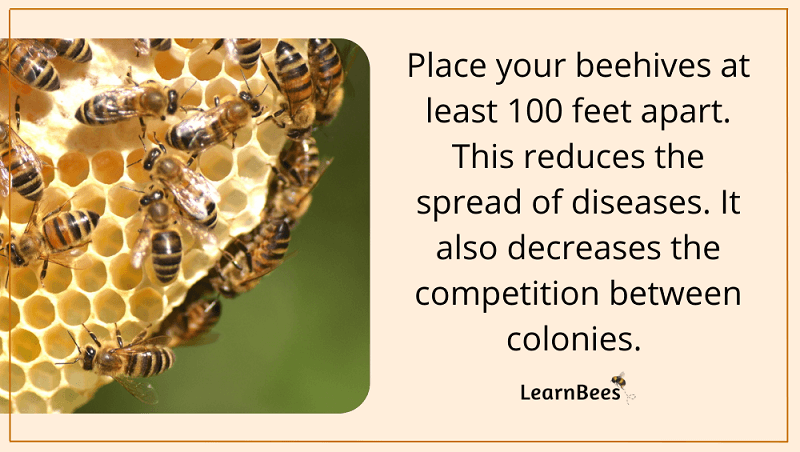
You shouldn’t place beehives within 100 feet of each other. The more space between them, the better.
You see, giving your honey bees more space between hives allows them to have less competition for flowers, better chances at reproducing (such as your queen not entering the wrong hive after mating), and less risk of being robbed.
Better yet?
The most significant benefit to having 100 feet (or more) between hives is that it reduces the spread of disease and parasites.
According to Dr. Seeley, parasites and diseases are a massive concern among beekeepers.
“It used to be a beekeeper would expect to lose 10 to 20 percent of colonies in a year, mostly over the winter,” he says. “And now the colony mortality can be 80 percent.”
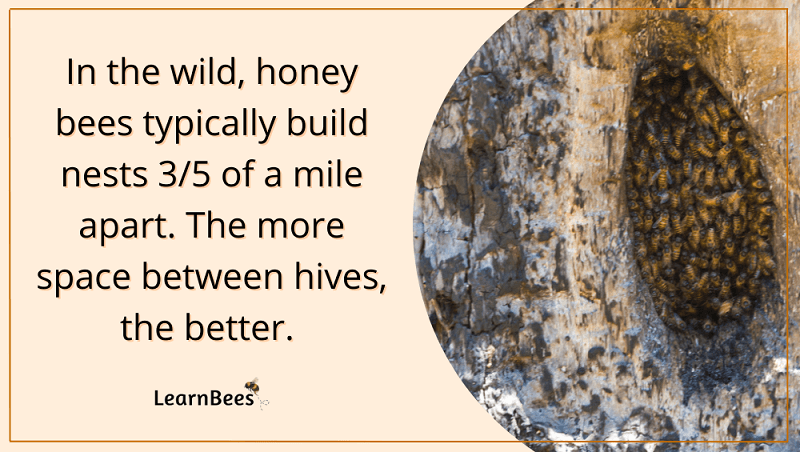
As such, Dr. Seeley has advocated for Darwinian Beekeeping, which encourages beekeepers to mimic a honey bee’s natural environment.
To do this, you should space your hives as far apart as possible. This helps prevent bees from entering the neighboring hive and spreading infections. In the wild, honey bees are typically 3/5 of a mile apart.
“That’s unrealistic for most beekeepers unless you live in a rural place,” Seeley says. In a suburban place, Seeley recommends keeping just one or two hives, with at least 100 feet between them.
But more space is better when it comes to placing beehives. So if you can place them 100 feet apart, good. If you can place them 300 feet apart, even better.
Where Is the Best Place to Put a Beehive?
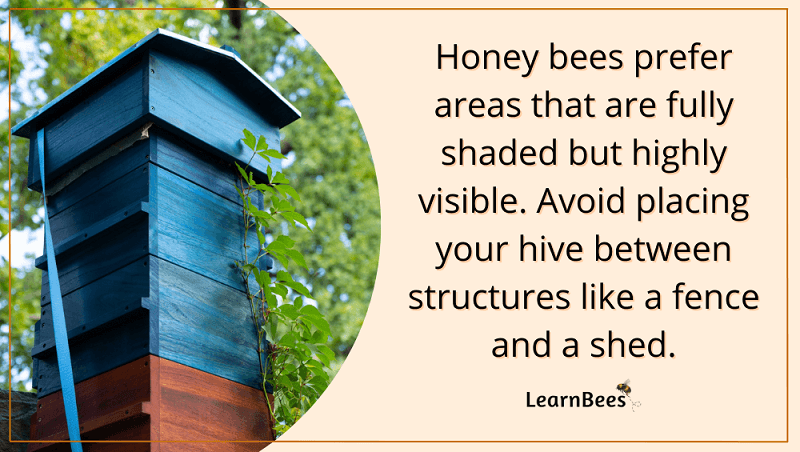
Honey bees prefer a location that is fully shaded but highly visible.
For example, a shady, south-facing beehive is ideal for beekeepers living in the northern hemisphere. A shady, north-facing beehive is best for beekeepers in the southern hemisphere.
Additionally:
Avoid tucking your hive between structures like a fence and a shed.
Instead, place your beehive in a location that has space around the hive. This not only gives you room when inspecting the hive, but it also gives the bees space to fly in and out.
After all, wild honey bees nest in trees.
Trees give the colony an open, shady area to nest in. This is especially crucial during the warm months as temperatures rise. Tree canopies also help protect them from elements like rain, wind, and snow.
And just as important:
Minimize relocations of hives.
If you must move your colony, try to do so when little forage is available. When your colony is moved to a new spot, the forager honey bees must relearn the area. This includes finding new water, nectar, and pollen sources. A study found that when bees moved to a new place, they weighed less than bees that remained in the same location.(3)
FAQs on “Which Direction Should a Beehive Face?”
- How far should a beehive be from a house?
- How high should a beehive be off the ground?
- Which way should beehive face?
- How close can you place beehives?
- Why should beehives face south?
- Should a beehive be in sun or shade?
- Can you put two beehives next to each other?
- Is it safe to have a beehive in your backyard?
How far should a beehive be from a house?
It’s best to place your beehive at least 25 feet from your house. This will give the bees enough room to fly safely in and out of the hive without being disturbed by you or your family members.
If you have a beehive with a feisty temperament, it’s best to have a distance of 50 feet or more from the house.
Ensure the beehives are far from busy walkways or places where children might play. The bees fly more in warm weather and are more protective of the hive entrance.
It’s also important to keep your hive at a safe distance between pets and neighbors. Neighbors can be nervous about bees, so it’s best to remain on good terms with them so they can call you with any questions.
Sometimes beekeepers put beehives close to the back door so they can watch the bees. This is fine, but it’s important to note that the colony’s temperament can vary drastically throughout the year.
For example, nectar dearth can result in defensive bees. Nectar dearths can occur during summer when high heat and little rainfall affect flower sources.
—> Go back to the FAQs on “Which Direction Should a Beehive Face?”
More to Explore:
How high should a beehive be off the ground?
Honey bees nest 15 feet or more above ground in their natural environment. This helps protect them from predators that can’t easily climb that high.
However, that isn’t practical for most beekeepers. We recommend keeping your beehive about two feet off the ground. This will help save your back from straining when inspecting the hive and harvesting honey.
Additionally, it keeps your hive off the damp ground when it rains.
—> Go back to the FAQs on “Which Direction Should a Beehive Face?”
More to Explore:
Which way should beehive face?
Your beehive should face the south in the northern hemisphere and the north in the southern hemisphere. This will give your colony plenty of sunlight and warmth during the winter months, which helps encourage them to take cleansing flights when needed.
Cleansing flights are important because they help keep the hive healthy by ensuring there isn’t a buildup of bee feces. Bee feces is unsanitary and can threaten the health of your colony.
—> Go back to the FAQs on “Which Direction Should a Beehive Face?”
More to Explore:
How close can you place beehives?
Keep at least 100 feet between your beehives to promote healthy bees. When beehives are placed too close to each other, they can intermingle and spread disease more quickly.
The spread of disease and parasites is a common problem beekeepers deal with. However, honey bees are healthier in the wild because they build their nests far apart from other colonies. In turn, this reduces the competition for pollen and nectar.
This strategy, known as Darwinian Beekeeping, encourages beekeepers to replicate a honey bee’s natural environment. As a result, you’ll have healthier, happier bees.
—> Go back to the FAQs on “Which Direction Should a Beehive Face?”
More to Explore:
- How Many Bees Are in a Hive?
- What is Backyard Beekeeping?
- Honey Extractors 101: Everything You Need to Know
Why should beehives face south?
In the northern hemisphere, beehives should face the south because this mimics a bee’s natural environment. Wild honey bees tend to prefer south-facing nests.
The reverse is true for the southern hemisphere. Beekeepers in the southern hemisphere should face their beehives towards the north.
—> Go back to the FAQs on “Which Direction Should a Beehive Face?”
More to Explore:
Should a beehive be in sun or shade?
Place beehives in the shade. This replicates how honey bees live in the wild since they nest in trees where tree canopies shade them. The best location is fully shaded but visible. You don’t want your beehive stuck between two structures – like a fence and shed.
Shade also helps protect your beehive from the natural elements. If the hives are placed in the sun, they’re also more vulnerable to rain, snow, and wind.
—> Go back to the FAQs on “Which Direction Should a Beehive Face?”
More to Explore:
- How Many Brood Boxes Should I Start With?
- How to Identify and Handle Queen Cells
- What Are the Langstroth Hive Dimensions?
Can you put two beehives next to each other?
We don’t recommend placing two beehives next to each other. Try to have at least 100 feet between hives because it reduces the chances that the bees will intermingle and spread diseases or parasites.
Additionally, it reduces the chances that a mated queen will fly into the wrong hive.
—> Go back to the FAQs on “Which Direction Should a Beehive Face?”
Is it safe to have a beehive in your backyard?
Having a beehive in your backyard is safe as long as you give them plenty of space between people and pets. Before joining the beekeeping hobby, you must check with your neighbors to ensure they’re comfortable with having a beehive nearby.
It’s also important to practice safe beekeeping techniques, like wearing protective gear around the hive and using smoke to calm the bees.
Beekeeping is a hobby that requires research before joining. You should read as much as you can to educate yourself about honey bees before starting a hive. Beekeeping takes commitment and dedication, but it’s also a rewarding experience.
It’s always important to remember that honey bees are living creatures and must be respected when working around them. With the right skills and tools, beekeeping can be a wonderful hobby for those interested in learning about these amazing insects.
—> Go back to the FAQs on “Which Direction Should a Beehive Face?”

